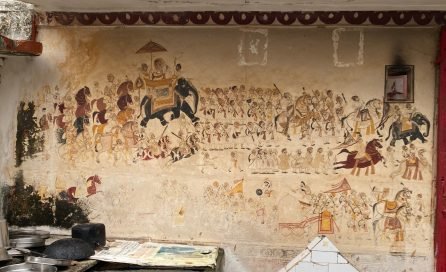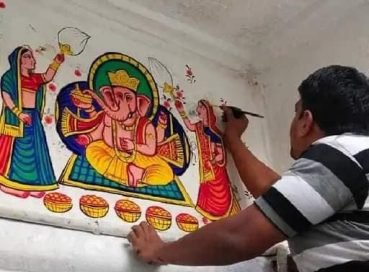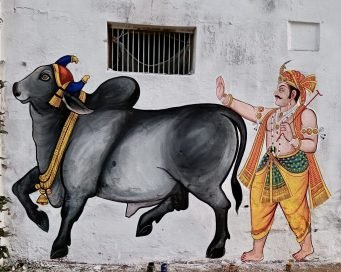The Tradition of Wall Paintings and Nathdwara Artists
The history of wall painting is an essential and time–honored tradition for the artists of Nathdwara. Dating back to at least the early 18 century, these wall paintings, murals, and frescoes are created both as commissioned works and as part of the artist’s seva (loving devotion) by the direct descendants of the artists who came with Shrinathji to Nathdwara in the 17th century, as well as the later communities of artists who came and settled here in the 19th century. Made both in and outside the limits of Nathdwara, these beautiful wall paintings are omnipresent, covering the interiors and exteriors of temples, homes (including the artist enclave of Chitrakaron ki gali), public spaces, and the most significant repository which can be found in and around the Shrinathji temple. In this blog, I will briefly discuss two notable pre-20th century examples of wall painting as well as two ongoing traditions within the art form.


In Nathdwara, frescos dating back to the early 19th century cover the interior and exterior of the Mobegarh Akhada. This structure, located on the edge of town, contains a small shrine to Shrinathji and is currently occupied as a residence. Sadly several wall paintings here have been damaged by construction or, even more alarmingly, whitewashed. Several of the remaining paintings are remarkably well preserved, considering their age. Subjects featured include Vaishnava symbolism and historical events, including a nearly life-sized image of Shrinathji, a joyful raas lila, and a dramatic procession featuring tilkayat Damodarji II, popularly called Dauji Maharaj, riding an elephant and surrounded by his cavalry.
Perhaps one of the most significant commissions of wall paintings by Nathdwara artists can be found at Juna Mahal in Dungarpur. Located approximately 150 kilometers south of Nathdwara, the former kingdom of Dungarpur was ruled by a Sisodia branch of the Mewar royal family. The seven-storey palace is replete with stunning frescoes and shimmering rooms of cut-glass inlay work. Subjects represented here are plentiful and include traditional Vaishnava imagery, battle scenes, mythological figures, and erotic imagery. The likeness of Surya, the Sun god, is peppered liberally throughout as the official emblem of the Sisodia dynasty who are purported to be descended from the Sun. Two exceptionally well-preserved frescoes include a large-scale raas lila and a durbar scene from a Gangaur festival painted in the early 20th century by the adi gaur Nathdwara artist Kanhaiyalal.


The current artists of Nathdwara have fastidiously continued the wall painting tradition, following in their ancestor’s footsteps. Between Dussehra and Diwali, the artists of Nathdwara gather under the guidance of the painting mukhiyaji, Parmanand Sharma, to repaint the entire temple of Shrinathji at Nathdwara. Old and young, from the most famous to those just starting out, gather to perform their personal seva. It is regarded as a significant honor for their entire family to have the opportunity to be able to perform this annual seva for every artist of Nathdwara. The artists collectively repaint all the wall paintings that grace the temple and other adjacent buildings. This task is finished before Diwali, so the temple looks refreshed for the start of the Hindu new year.
Another tradition that occurs each year immediately following Gopashtami and Annakut is painting murals at the Nathdwara goshala (cowshed). Following the festivals’ dramatic processions of intricately embellished cows and ceremonious govardhan puja at the Shrinathji temple, the cows are led back to the goshala where they reside. Here, playful, yet majestic images are painted as a homage to these revered animals, their home, and their deeply-rooted position in Nathdwara’s history. Beneath, we see a recently completed wall painting by the renowned artist Raghunandan Sharma and his nephew, Suresh Sharma.

The practice of wall painting in Nathdwara contributes a crucial component of tradition, community, and beauty which operate in tandem to preserve these salient tenets of Nathdwara’s heritage. These types of traditions allow the artists of Nathdwara to venerate Shrinathji, honor their ancestors, and preserve the culture and their collective legacies for generations to come.
Aleksandra Matic
Fulbright-Nehru Fellow, 2022-2023
